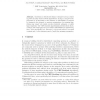Free Online Productivity Tools
i2Speak
i2Symbol
i2OCR
iTex2Img
iWeb2Print
iWeb2Shot
i2Type
iPdf2Split
iPdf2Merge
i2Bopomofo
i2Arabic
i2Style
i2Image
i2PDF
iLatex2Rtf
Sci2ools
116
click to vote
DCOSS
2009
Springer
2009
Springer
Fast Self-stabilization for Gradients
Abstract. Gradients are distributed distance estimates used as a building block in many sensor network applications. In large or long-lived deployments, it is important for the estimate to self-stabilize in response to changes in the network or ongoing computations, but existing algorithms may repair very slowly, produce distorted estimates, or suffer large transients. The CRF-Gradient algorithm[1] addresses these shortcomings, and in this paper we prove that it self-stabilizes in O(diameter) time—more specifically, in 4 · diameter/c + k seconds, where k is a small constant and c is the minimum speed of multi-hop message propagation. 1 Context A common building block for distributed computing systems is a gradient—a biologically inspired operation in which each device estimates its distance to the closest device designated as a source of the gradient (Figure 1).3 Gradients are commonly used in systems with multi-hop wireless communication, where the network diameter is likely to...
DCOSS 2009 | Distance Estimates | Distorted Estimates | Distributed And Parallel Computing | Gradient |
Related Content
| Added | 26 May 2010 |
| Updated | 26 May 2010 |
| Type | Conference |
| Year | 2009 |
| Where | DCOSS |
| Authors | Jacob Beal, Jonathan Bachrach, Daniel Vickery, Mark Tobenkin |
Comments (0)

